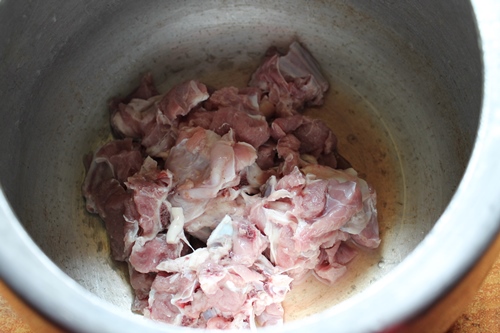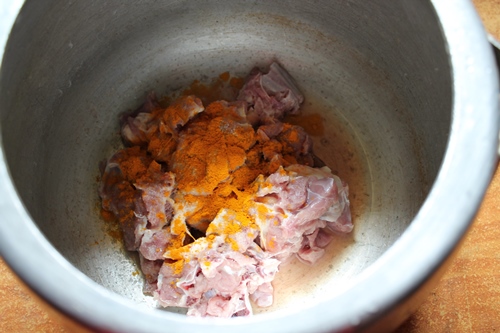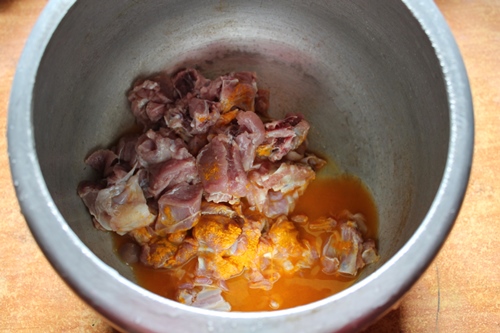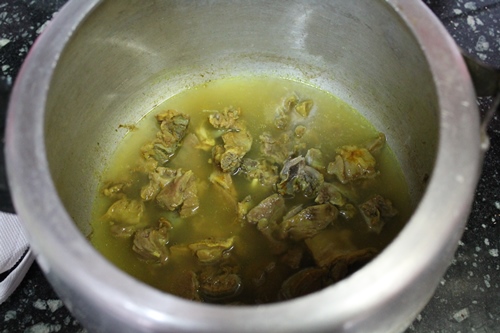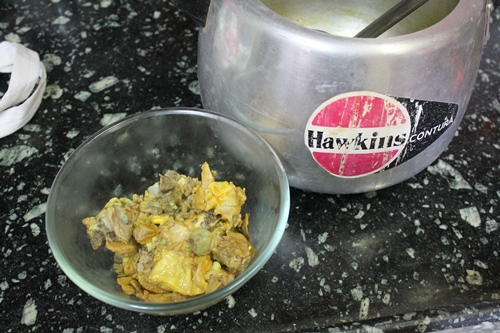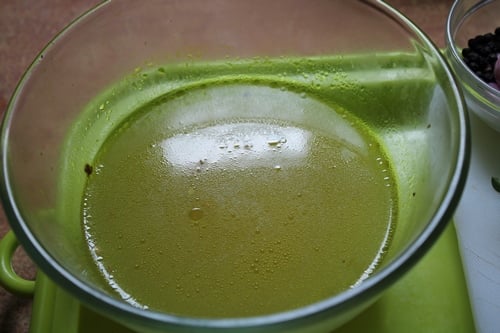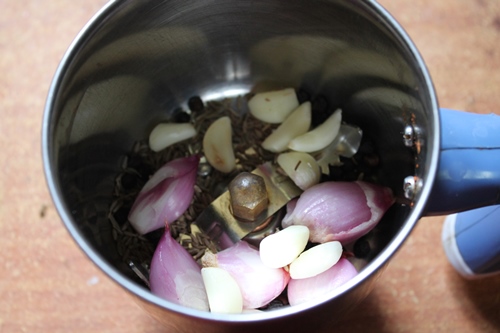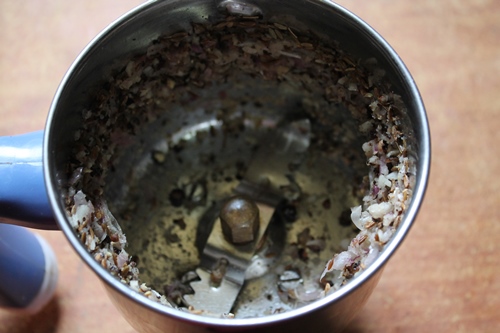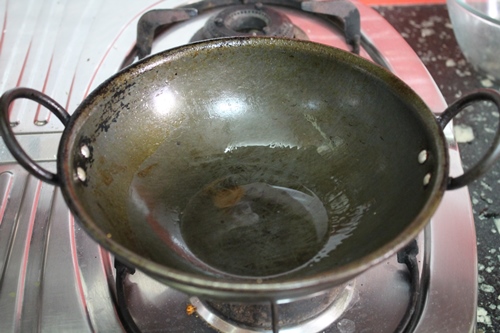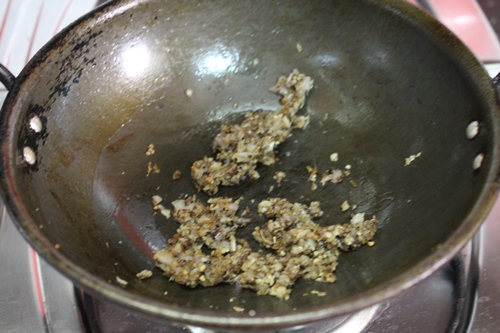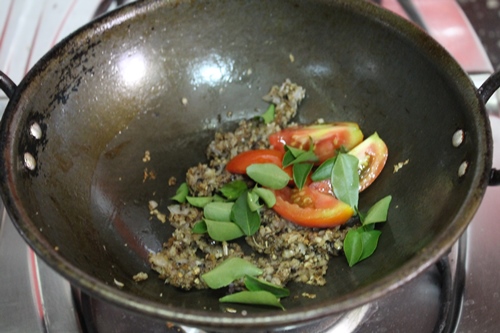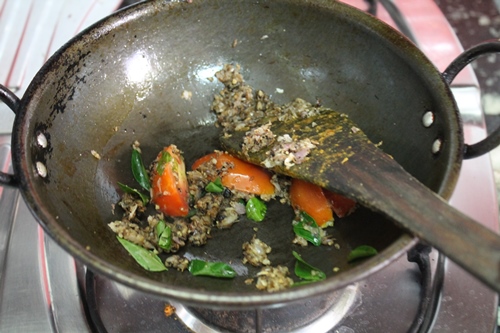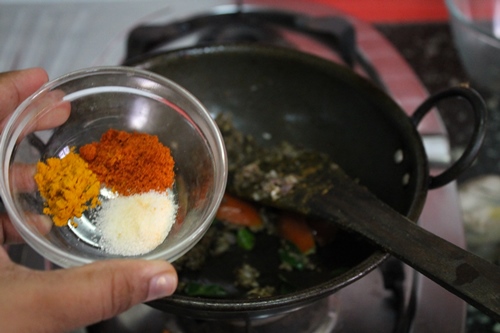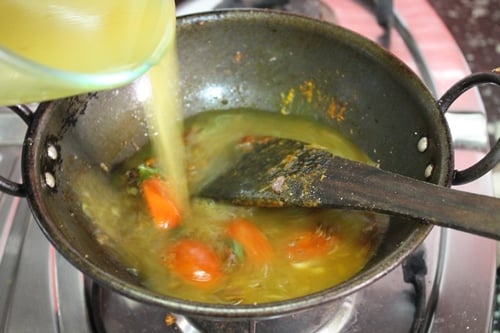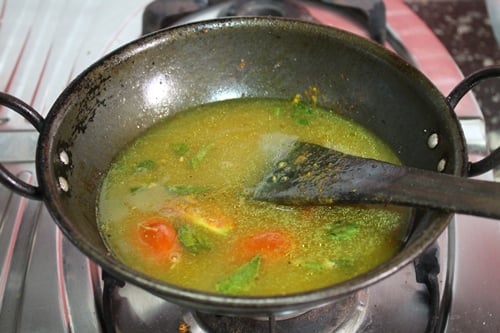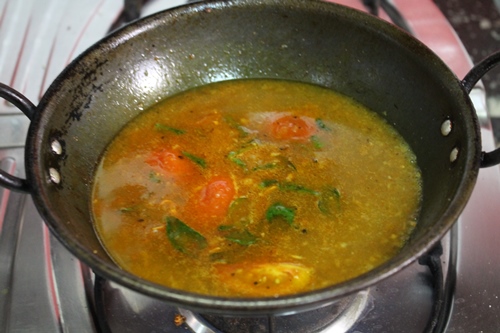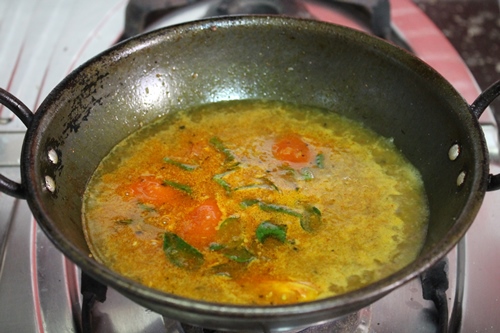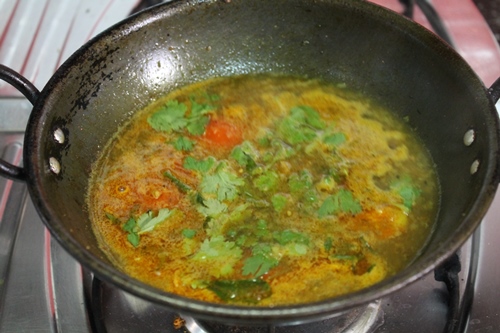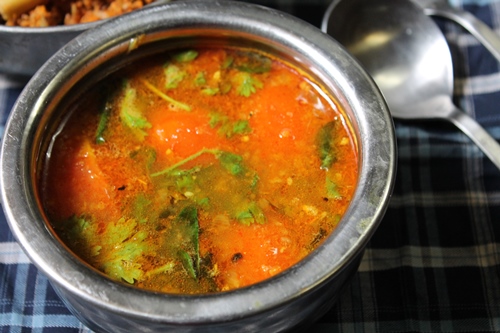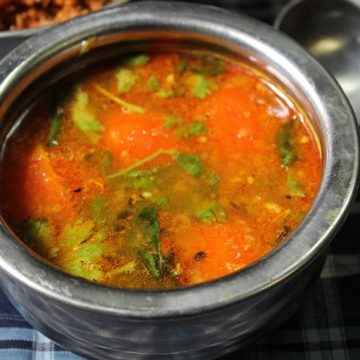
Mutton Rasam is a flavorful South Indian soup made using tender mutton pieces cooked with spices and a special ground masala. It’s usually served as a comforting rasam soup or mixed with rice as rasam rice. This dish is known not only for its delicious taste but also for being rich in nutrients that help strengthen bones and boost immunity, thanks to the mutton stock. The rasam is slightly tangy, spicy, and aromatic with the goodness of garlic, cumin, pepper, and fresh curry leaves. It’s a traditional remedy often made at home when someone has a cold or needs a warm, healing meal.


Mutton Rasam
I have been mentioning this recipe in my mutton thoran recipe. It is one of the yummiest rasam I made, plus you got two recipes from one. This rasam is one of the comforting recipe, and it is really good for you and your throat when you have cold or you are really sick. So next time when you get mutton just this and the mutton thoran and let me know how it turned out.
Jump to:
About Mutton Rasam
This recipe is something I’ve been sharing alongside my Mutton Thoran recipe because it’s a perfect combo, two tasty dishes from one batch of mutton. The rasam itself is quite comforting and especially soothing if you have a cold or sore throat. The warm spices and garlic work like magic to ease discomfort. The beauty of this recipe is its simplicity and health benefits. Pressure cooking the mutton extracts all the natural flavors and nutrients into the stock, which forms the base of the rasam.
You get a lovely balance of spices with turmeric and chili powder, and the use of fresh curry leaves and coriander leaves adds a fresh aroma to the dish. The tomato gives a slight tang that brightens up the soup. What’s really nice is that this rasam is quite light, so it doesn’t feel heavy but still fills you up nicely when served with plain rice.
This dish is also very versatile, you can have it as a soup on a chilly day or pour it over steamed rice for a flavorful meal. It’s one of those recipes that comfort you in every sense, taste, warmth, and nourishment.
Similar Mutton Recipes


Why This Recipe Works
The key to this recipe is the pressure-cooked mutton stock. Cooking the meat with turmeric and salt allows all the flavors to develop deeply, making the rasam rich and tasty. Then, grinding the shallots, garlic, cumin, and pepper into a paste ensures every bite is packed with flavor and a little heat. Adding the ground masala to hot coconut oil helps release the essential oils of the spices, making the rasam fragrant and delicious. The slow simmer of the stock with this masala blends everything perfectly. Lastly, adding fresh curry leaves and coriander right before serving lifts the flavor and gives it a fresh, herbal finish. This process not only enhances the taste but also keeps the nutrients intact, making it both comforting and wholesome.
Why I Love This Recipe – I’ve always loved this recipe because it reminds me of home and those rainy days when my mom would make this rasam to warm us up. It’s simple, comforting, and something that feels like a hug in a bowl. My family loves it too, especially when served with plain steamed rice. It’s a dish that brings everyone together, and it’s a must-have whenever there’s a cold or cough in the house.
The best part is how you get two dishes from one, using the cooked mutton for another recipe like mutton thoran makes it even better. The balance of spices is just right for me, not too overpowering but full of flavor. It’s also a healthier way to enjoy mutton without the heaviness of rich gravies. Sometimes, I even sip it as a warm drink on chilly evenings, it’s that comforting. And over time, it has become one of those recipes I always come back to when I need a little bit of warmth and nostalgia.
Ingredients


Mutton or Lamb – ½ kg (with bone preferred): Go for small, bite-sized pieces with bone. The bones give the rasam a rich flavor when pressure-cooked. If you don’t like bones, you can use boneless, but the soup won’t be as flavorful. Wash the meat well before cooking.
Tomato – 1 medium-sized, chopped: Tomatoes add a nice tangy taste and balance the spiciness of the rasam. Make sure it’s ripe, as that gives the best flavor.
Shallots / Small Onions – 4, peeled and sliced: These small onions add a light sweetness and body to the rasam. If you don’t have shallots, you can use half of a regular onion, but shallots are preferred for their distinct taste.
Garlic – 6 cloves, peeled: Garlic adds warmth and depth to the rasam. It also has health benefits and gives the rasam that home-style touch.
Cumin Seeds – 1 teaspoon: Adds a nice earthy flavor and helps with digestion. Toasting or grinding fresh cumin makes a big difference in flavor.
Whole Black Pepper – 1 teaspoon: This gives the rasam its signature heat, not too strong, but enough to warm you up, especially good during colds or rainy days.
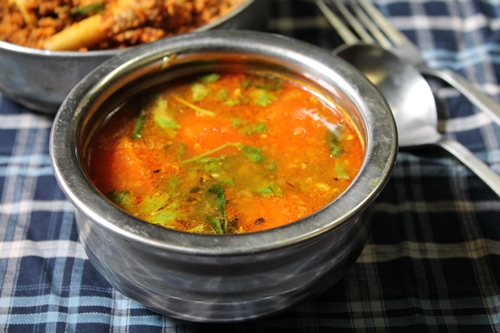

Hacks
Pressure Cooking is a Must
Don’t skip the pressure cooker step. Cooking the mutton with turmeric and salt under pressure not only makes the meat soft and tender but also pulls out all the goodness from the bones into the stock. That’s what makes the rasam nourishing and tasty.
Grind the Masala Fresh
Instead of using store-bought powders, grind the shallots, garlic, cumin, and pepper freshly. This makes a big difference in taste. Crushing them slightly rather than making a fine paste can also give a nice texture and more flavor as it simmers in the stock.
Adjust Spice to Your Liking
You can easily play around with the spice level. If you’re making this for kids or someone who’s not well, reduce the chili and pepper a bit. For those who enjoy heat, add a bit more pepper while grinding or a small green chili while boiling the rasam.
Don’t Waste the Cooked Mutton
After pressure cooking, you’ll separate the mutton from the stock. Don’t throw away the mutton pieces! They are soft and full of flavor and can be used to make mutton thoran, a dry stir-fry, or even a simple curry with onions and coconut. It’s a smart way to make two dishes at once and avoid waste.


Mutton Rasam (Step by Step Pictures)
Expert Tips
Storage
Mutton rasam stays good in the fridge for up to two days. Just let it cool completely before storing it in an airtight container. When you want to reheat it, do so gently on the stove over low heat. If it has thickened a bit after sitting, you can add a little water to bring it back to the right consistency. It still tastes great the next day, sometimes even better as the flavors have more time to settle in.
Serving
This rasam is perfect with plain steamed rice. It’s light but full of flavor, and it makes a comforting meal, especially on cooler days or when someone’s feeling under the weather. You can also enjoy it as a warm, spicy soup on its own. To make the meal more complete, serve it with simple sides like a vegetable stir-fry, thoran, or even just some crispy papad.
Freshness
Adding fresh coriander and curry leaves right at the end, just before turning off the heat makes a big difference. It keeps the rasam smelling and tasting fresh and bright. Avoid adding them too early, as they’ll lose their flavor and color if overcooked.
Pressure Cooker Tip
When pressure cooking the mutton, it’s important to let the pressure release naturally. This helps the meat stay soft and juicy. Forcing it open too soon can make the meat tough and also affects the flavor of the stock. Taking that little extra time makes the rasam much better in the end.
FAQ
Q: Can I use chicken instead of mutton?
A: Yes, you definitely can. Chicken works well for a lighter version of this rasam. Just remember that chicken cooks much faster than mutton, so you won’t need to pressure cook it for as long, usually just a few whistles or a gentle simmer until it’s cooked through. The taste will be slightly different, but still comforting and flavorful.
Q: Can I skip pressure cooking?
A: Technically, yes, but it’s not ideal for mutton. Cooking mutton on a regular stovetop without pressure will take a lot longer and the meat may turn out a bit tough. Pressure cooking helps break down the meat nicely and also draws out deep flavors into the stock, which makes the rasam rich and tasty. So if you have a pressure cooker, it’s definitely worth using.
Q: Can I make this rasam spicier?
A: Of course! You can adjust the heat to suit your taste. Just add a bit more chili powder or freshly ground pepper if you like it hot. If you’re cooking for someone who prefers it mild, simply reduce the spice and it’ll still taste great. Rasam is quite flexible like that.
Q: What if I don’t have coconut oil?
A: No worries. You can use any cooking oil that you normally use, like sunflower or vegetable oil. However, using coconut oil does give the rasam a lovely, traditional South Indian flavor and aroma. If you have it on hand, it’s worth using, but the dish will still turn out fine without it.
Variations
Add a Tangy Twist – If you enjoy your rasam with a little more tang, try adding a squeeze of fresh lemon juice right at the end before serving. It gives a bright, refreshing taste that works really well, especially when you’re sipping it like soup.
Tamarind for a Deeper Sourness – For a more traditional touch, you can use tamarind extract instead of lemon juice. Just a small spoon of it gives a richer, sharper sour flavor that blends beautifully with the spices and mutton stock.
Make It More Wholesome – Want to make your rasam a bit more hearty? Try adding chopped vegetables like drumsticks or carrots when pressure cooking the mutton. The veggies absorb all the delicious flavors and make the dish more filling and nutritious.
Thicker Rasam Option – If you like your rasam on the thicker side, mash a small amount of cooked toor dal (split pigeon peas) and stir it into the stock before boiling. It adds a mild creaminess and a slightly heavier texture, which goes perfectly with rice.
More Mutton Recipes to Try
📖 Recipe Card
Mutton Rasam Recipe
Servings: 6 servings
Calories: 269kcal
Instructions
Pre-prep: First, gather all my ingredients. chop the mutton into small pieces and peel and slice the shallots. I also peel the garlic cloves and chop the tomato. Getting everything ready helps the cooking go smoothly. Rinse the curry leaves and coriander and keep them aside for later use.
Making the Masala Paste: Take the shallots, garlic, cumin seeds, and whole pepper and grind them together into a coarse paste. This paste is the heart of the rasam and gives it a great flavor boost. If it’s too dry while grinding, add a tiny splash of water just to help it blend.
Cooking the Mutton Stock: In a pressure cooker, add the chopped mutton, turmeric, salt, and 2 cups of water. After sealing the cooker, pressure cook it for 10 whistles and then let it simmer on low heat for another 10 minutes. After turning off the heat, let the pressure release naturally. This step makes the mutton tender and infuses the stock with rich flavors. Sometimes skim off any foam or excess fat from the top of the stock to keep the rasam clear and light.
Making the Rasam: Drain the cooked mutton and reserve the stock. While the meat can be used for another dish like mutton thoran, the stock becomes the base for the rasam. heat coconut oil in a pan and add the ground masala paste, sautéing it until the raw smell disappears. Then add chopped tomatoes and curry leaves and sauté them lightly. After this, add turmeric powder, chili powder, and salt, mixing everything well. Finally, pour in the mutton stock and bring it to a boil. Once boiling, turn off the heat and garnish with fresh coriander leaves. The rasam is ready to serve.
Video


Notes
Storage
Mutton rasam stays good in the fridge for up to two days. Just let it cool completely before storing it in an airtight container. When you want to reheat it, do so gently on the stove over low heat. If it has thickened a bit after sitting, you can add a little water to bring it back to the right consistency. It still tastes great the next day, sometimes even better as the flavors have more time to settle in.Serving
This rasam is perfect with plain steamed rice. It’s light but full of flavor, and it makes a comforting meal, especially on cooler days or when someone’s feeling under the weather. You can also enjoy it as a warm, spicy soup on its own. To make the meal more complete, serve it with simple sides like a vegetable stir-fry, thoran, or even just some crispy papad.Nutrition
Serving: 1serving | Calories: 269kcal | Carbohydrates: 3g | Protein: 14g | Fat: 22g | Saturated Fat: 10g | Polyunsaturated Fat: 2g | Monounsaturated Fat: 8g | Cholesterol: 61mg | Sodium: 57mg | Potassium: 283mg | Fiber: 1g | Sugar: 1g | Vitamin A: 348IU | Vitamin C: 17mg | Calcium: 32mg | Iron: 2mg
If you have any questions not covered in this post and if you need help, leave me a comment or mail me @[email protected] and I’ll help as soon as I can.
Follow me on Instagram, Facebook,Pinterest ,Youtube and Twitter for more Yummy Tummy inspiration.
IF YOU MAKE THIS RECIPE OR ANYTHING FROM YUMMY TUMMY, MAKE SURE TO POST IT AND TAG ME SO I CAN SEE ALL OF YOUR CREATIONS!! #YUMMYTUMMYAARTHI AND @YUMMYTUMMYAARTHI ON INSTAGRAM!
More Rasam Recipe
Reader Interactions

Source link
